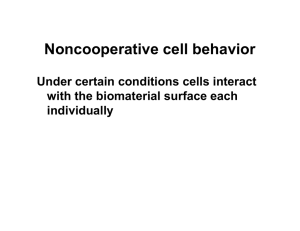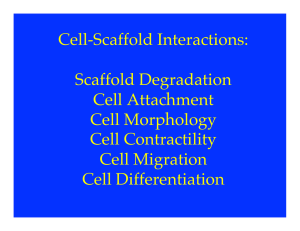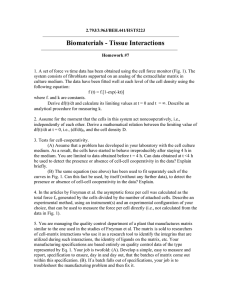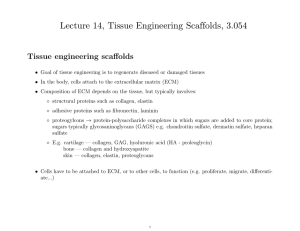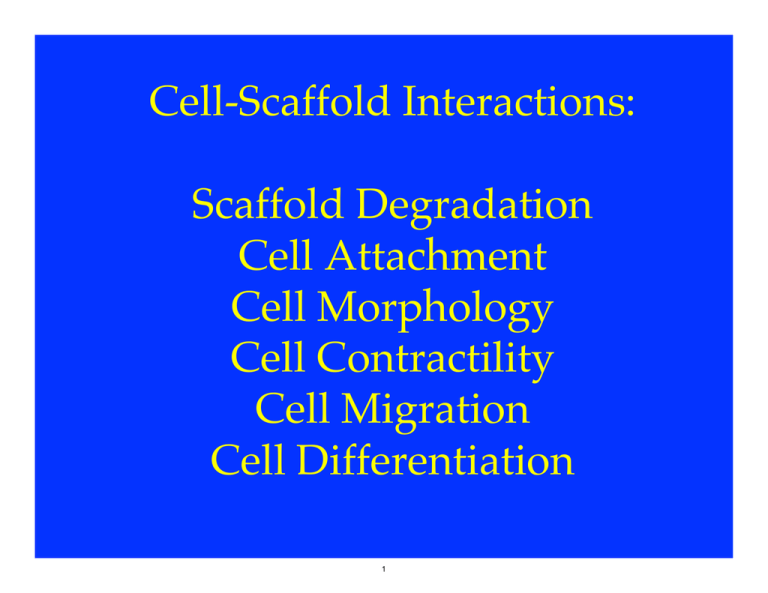
!
Cell-Scaffold Interactions:!
!
Scaffold Degradation!
Cell Attachment!
Cell Morphology!
Cell Contractility!
Cell Migration!
Cell Differentiation"
1
Cell scaffold interactions
• Scaffolds also being used to characterize cell-scaffold interactions, e.g. how cell behavior (attachment,
migration, contraction, differentiation) is affected by substrate
Scaffold degradation
• Native ECM — enzymes produced by cells resorb ECM over time;
cells also synthesize new ECM to replace it
e.g. bone — rates of resorption and synthesis depend on loading
• Cells also degrade tissue engineering scaffolds
• Length of time scaffold remains insoluble called “residence time”
• Require scaffold degradation to occur in a manner that does not interfere with new ECM synthesis
• Scaffold residence time must be approximately equal to the time required to synthesize new ECM
2
• Degradation rate for scaffold depends on its chemical composition and cross-linking, and on relative
density of scaffold
• Synthetic polymers — can vary molecular weight of polymers and ratio of co-polymers; e.g. PLGA
higher GA:LA ratio polymers degrade quicker
• Collagen-based scaffolds — can control degree of cross-linking
Physical methods:
— dehydrothermal (DHT) treatment (105◦ C vacuum 24 hours)
— removes water, forms interchain bonds through condensation
— UV treatment
Chemical methods:
— glutaraldehyde; carbodiimide treatments
3
Cell adhesion
• Cells attach to ECM at focal adhesion
• At focal adhesion:
◦ cell has integrins — trans membrane proteins that bind to ligands on ECM; other end of
integrin connects to sub-membrane plaque that then connects to cell’s cytoskeleton (e.g. to
actin filaments)
• Cell behaviors such as attachment, migration, proliferation, contraction affected by interactions be­
tween focal adhesions and integrins
• Biological activity of scaffolds depends on density of ligands available for integrins to bind to
• Ligand density depends on composition of scaffold and surface area/volume of scaffold
• Biological polymers, that are constituents of native ECM (e.g. collagen) have a range of native
binding sites
• Synthetic polymers don’t have binding sites and need to be functionalized with adhesive proteins
such as fibronectin and laminin
4
• Specific surface area (SA/vol) of scaffold depends on pore side d and relative density:
• For a tetrakaidecahedral unit cell:
SA
1 ρ∗
∝
v
d ρs
1/2
SA 2πrln
r
r 1
=
∝
∝
∝
v
l3
l2
l l
ρ∗
ρs
1/2
1
d
• Dependance of cell attachment on specific surface area was measured by seeding cells (MC3T3-E1
mouse osteogenic) onto collagen-GAG scaffolds of constant relative density (ρ∗ /ρs = 0.006) and vary­
ing pore size)
d = 96, 110, 121, 151µm
• Number of cells attached measured at 24, 48 hours
• Fraction of cells attached increased linearly with specific surface area
Cell morphology
• Cell orientation follows scaffold pore orientation
• Cell morphology can depend on a substrate stiffness
Cell contraction
see slides
Cell migration
5
Cell Adhesion"
Gibson, L. J., M. Ashby, et al. Cellular Materials in Nature and Medicine. Cambridge University
Press. © 2010. Figure courtesy of Lorna Gibson and Cambridge University Press.
Figure removed due to copyright restrictions. See Figure 9.1: Gibson, L. J., M. Ashby, et al.
Cellular Materials in Nature and Medicine. Cambridge University Press, 2010.
http://books.google.com/books?id=AKxiS4AKpyEC&pg=PA255
Gibson, Ashby and Harley, 2010"
6
Cell Attachment"
SA 3.65 ⎛ ρ ⎞
=
⎜ ⎟
V
l ⎝ ρs ⎠
* 1/ 2
0.718
=
d
Open-cell tetrakaidecahedron
Circular cross-section edges
l = edge length
d = pore size
Collagen-GAG scaffold:
s = 0.005, d = 96, 110, 121,
150m
7
Cell Attachment"
Percent Cell Attachment
60
40
R2 = 0.95
20
R2 = 0.91
24 hrs post-seeding
48 hrs post-seeding
0
0.00400
0.00500
0.00600
0.00700
-1
m -1
Specific Surface Area, ?m
0.00800
O'Brien, B. A. Harley, I. V. Yannas, et al. Biomaterials 26 (2005): 433-41.
Courtesy of Elsevier. Used with permission.
http://www.sciencedirect.com/science/article/pii/S0142961204002017
O’Brien
O’Brien"
Mouse MC3T3 osteogenic cells
on collagen-GAG scaffold"
8
Cell Morphology"
PLGA scaffolds"
Seeded with
rotator cuff
fibroblasts"
fibroblasts
Random
Random"
Aligned
Aligned"
Moffat, K. L., et al. Clinics in Sports Medicine 28 (2009): 157-76.
Courtesy of Elsevier. Used with permission.
http://www.sciencedirect.com/science/article/pii/S0278591908000707
Moffat et al, 2009b"
9
Cell Morphology"
E=
11.6
"
67
"
147"
"497 Pa"
Dikovsky, D. H., et al. Biophysical Journal 94 (2008): 2914-25.
Courtesy of Elsevier. Used with permission.
http://www.sciencedirect.com/science/article/pii/S0006349508705411
Smooth muscle cells encapsulated"
in a PEG-fibrinogen hydrogels of varying modulus"
"
Dikovsky et al., 2008
10
Cell Contractility:!
Wound Contraction !
and Scar Formation"
Wound contraction associated
with scar formation
Use of collagen-GAG matrix
inhibits wound contraction and
scar formation; results in
synthesis of normal dermis
Image source unknown. All rights reserved. This content is excluded from our Creative
Commons license. For more information, see http://ocw.mit.edu/help/faq-fair-use/.
Photo courtesy of IV Yannas"
This observation has led to interest in contractile response of cells on
the scaffold
11
Contractility of Cells"
• Biological cells can contract a scaffold"
• Free-floating tests"
– Measure diameter change"
• Developed cell force monitor (CFM) to
measure forces"
12
Collagen-GAG Scaffold
Pek et al., 2004
Fig. 1: Pek, Y. S., M. Spector, et al. Biomaterials 25 (2004): 473-82.
Courtesy of Elsevier. Used with permission.
http://www.sciencedirect.com/science/article/pii/S0142961203005416
Scaffold developed by IV Yannas (MIT)
13
Cell Force Monitor
(CFM) Collagen-GAG
Matrix
Freyman
Adjustable
Horizontal Stage
To Amplifier / PC
Be-Cu
Beam
Rotation
Stage
Matrix
Proximity
Sensor
Adjustable
Height
Post
Silicone
Well
Base Plate
10
Source: )UH\PDQ70HWDO)LEUREODVW&RQWUDFWLOH)RUFHLV,QGHSHQGHQWRIWKH6WLIIQHVVZKLFK5HVLVWVWKH&RQWUDFWLRQ
([SHULPHQWDO&HOO5HVHDUFK&RXUWHV\RIAcademic Press/(OVHYLHU8VHGZLWKSHUPLVVLRQ
14
CFM: Effect of Cell Number
Force [mN]
Force
(mN)"
15
F = Fasymptote (1− e−t/τ )
10 Million Attached
Fibroblasts at 22h
10
7.2
6.0
4.4
5
2.3
0
0
6
12
18
-5
Time [Hours]
Freyman"
Time constant 5.7 hours
Freyman, T. M., I. V. Yannas, et al. "Fibroblast Contraction of a Collagen-GAG Matrix."
Biomaterials 22 (2001): 2883-91. Courtesy of Elsevier. Used with permission.
15
24
Effect of Cell Number"
Asymptotic
Force(mN)"
[mN]
Asymptotic
Force
15
Fa = 1.0·Nc + 1.2
R2 = 0.97
(2)
10
(3)
(3)
5
(4)
(n=4)
Force Per Cell ~ 1nN
0
0
4
8
Number of Attached Fibroblasts at 22 Hours [Millions]
Freyman"
Freyman, T. M., I. V. Yannas, et al. "Fibroblast Contraction of a Collagen-GAG Matrix."
Biomaterials 22 (2001): 2883-91. Courtesy of Elsevier. Used with permission.
16
12
Effect of System Stiffness"
Displacement perper
Cell Cell
[nm] (nm)"
Displacement
4.0
0.7 N/m
2.5
1.4 N/m
1.0
-0.5
Stiffness = 10 N/m
0
6
12
18
24
Time [Hours]
Freyman, T. M., et al. Fibroblast Contractile Force is Independent of the Stiffness which Resists the Contraction."
"
Experimental Cell Research 272 (2002): 153-62.
Courtesy of Elsevier. Used with permission.
-
Freyman"
17
Effect of System Stiffness"
Force
Force
perCell
Cell [nN]
per
(nN)"
4
3
Stiffness = 1.4 N/m
0.7 N/m
2
10 N/m
1
0
0
6
12
18
24
-1
Time [Hours]
Freyman, T. M., et al. Fibroblast Contractile Force is Independent of the Stiffness which Resists the Contraction."
"
Experimental Cell Research 272 (2002): 153-62.
Courtesy of Elsevier. Used with permission.
-
Freyman"
18
Methods: Cell Elongation!
Average aspect ratio of cells"
– Time points 0, 4, 8, 15, 22, and 48 h (n=3)"
– Hematoxylin & eosin (H&E) stained
glycomethacrylate (GMA) sections (5mm)"
– Digital image analysis (~200 cells per sample)!
19
Fibroblast Morphology
Figure removed due to copyright restrictions. See Figure 3: Freyman, T. M., et al. "Micromechanics of
Fibroblast Contraction of a Collagen–GAG Matrix. Experimental
Cell Research 269 (2001): 140-53.
"
-
Freyman
20
Fibroblast Morphology
3.5
AR = ARasymptote (1− e−t/τ )
Aspect
Ratio
Aspect
Ratio"
3.0
2.5
2.0
Time constant ~ 5 hours
1.5
1.0
0
Freyman"
10
20
30
Time (h)
40
50
Source: Freyman, T. M., et al. Experimental Cell Research 269 (2001): 140-53.
Courtesy of Elsevier. Used with permission.
http://www.sciencedirect.com/science/article/pii/S0014482701953029
21
60
Time Constants"
• Time constant for contraction ~ 5.7
hours"
• Time constant for elongation ~ 5 hours"
• Suggests a link between the average "
elongation of the cell population and
the macroscopic contraction of the
population"
22
Methods: Live Cell Imaging"
Infinity Corrected Objective
Cover Slip
Thick Microscope Slide with Well
Cell Seeded
Matrix
Heated Stage
Source: Freyman, T. M., et al. Experimental Cell Research 269 (2001): 140-53. Courtesy of Elsevier. Used with permission.
http://www.sciencedirect.com/science/article/pii/S0014482701953029
23
2m
Live Cell "
Imaging!
50 mm
Freyman"
42m
38m
33m
28m
26m
25m
23m
19m
3h
20
24
Live Cell
Imaging
Figure removed due to copyright restrictions. See Figure 7: Freyman, T. M., et al. "Micromechanics
of Fibroblast Contraction of a Collagen–GAG Matrix." Experimental Cell Research 269 (2001): 140-53.
Freyman"
25
Live Cell Imaging"
Source: Freyman, T. M., et al. Experimental Cell Research 269 (2001): 140-53.
Courtesy of Elsevier. Used with permission.
http://www.sciencedirect.com/science/article/pii/S0014482701953029
26
Schematic
of cell
elongation
and
matrix
contraction
Figure removed due to copyright restrictions. See Figure 7a-d: Freyman, T. M., et al.
"Micromechanics of Fibroblast Contraction of a Collagen–GAG Matrix.
Experimental Cell Research 269 (2001): 140-53.
Freyman"
27
Discussion"
• Cell elongation linked to contraction"
– time constants for cell elongation and
contractile force development similar
( ~ 5h) "
– as cell elongates, observe gap between
central portion of cell and matrix"
– adhesion points at periphery of cell"
– tensile forces in actin filaments induce
compression in the matrix => buckling "
28
Single Cell Contractile Force"
• Contraction: cell buckling"
• Measure Es from AFM bending test"
• Allows calculation of contractile force of
single fibroblast"
29
Single Cell Contractile Force"
Es = 762 MPa"
(dry) "
"
"Es = 5.28 MPa"
"(wet)"
Source: Harley, B. A., et al. Acta Biomaterialia 3 (2007): 463-74.
Courtesy of Elsevier. Used with permission.
http://www.sciencedirect.com/science/article/pii/S1742706107000025
Harley, Silva"
30
Single Cell Contractile Force"
n π E sI
• Euler buckling:" F =
2
l
2
2
πd 4
I=
64
"n2 = 0.34 (hydrostatic loading of
tetrakaidecahedral cells (Triantafillou)"
d = 3.9 +/- 0.8 m; l from live cell imaging
"
"Fc = 11 to 41 nN (average 26 nN)"
"
Harley, Wong"
31
Cell Migration
Figure removed due to copyright restrictions. Figure
3: Cornwell, K. G., et al. Journal of Biomedical
Material Research A 80 (2007): 362-71.
http://onlinelibrary.wiley.com/doi/10.1002/jbm.
a.30893/abstract
Migration speed on onedimensional fiber
constructs
NIH 3T3 cells on 2D flat
substrate:
Cells on soft substrate
cross to stiff substrate
Cells on stiff substrate
will not cross onto soft
substrate; instead spread
out at boundary Source: Lo, et al., Biophysical Journal 79 (2000): 144-52.
Courtesy of Elsevier. Used with permission.
http://www.sciencedirect.com/science/article/pii/S0006349500762795
Top: Cornwell et al., 2007; Bottom: Lo et al, 2000
32
Cell Migration:!
Fibroblasts in CG Scaffold"
Courtesy of Brendan Harley. Used with permission.
33
Confocal "
Microscopy"
"
NR6 Fibroblasts"
CMFDA Live"
Cell Tracker"
"
CG Scaffold"
Alexa Fluor 633"
Stain"
Harley"
Fibroblast Migration: !
Spot Tracking"
Harley"
Courtesy of Brendan Harley. Used with permission.
34
Migration Speed !
vs Strut Stiffness"
Source: Harley, B. A. C., et al. Biophysical Journal 95 (2008): 4013-24.
Courtesy of Elsevier. Used with permission.
http://www.sciencedirect.com/science/article/pii/S0006349508785394
35
Migration Speed vs Pore Size"
Source: Harley, B. A. C., et al. Biophysical Journal 95 (2008): 4013-24.
Courtesy of Elsevier. Used with permission.
http://www.sciencedirect.com/science/article/pii/S0006349508785394
36
Migration Speed vs Pore Size"
Source: Harley, B. A. C., et al. Biophysical Journal 95 (2008): 4013-24.
Courtesy of Elsevier. Used with permission.
http://www.sciencedirect.com/science/article/pii/S0006349508785394
37
Migration Speed vs Pore Size"
Source: Harley, B. A. C., et al. Biophysical Journal 95 (2008): 4013-24.
Courtesy of Elsevier. Used with permission.
http://www.sciencedirect.com/science/article/pii/S0006349508785394
38
Cells on scaffolds with "
smaller pore sizes have
a higher speed both
along a strut and at a
strut junction than cells
in scaffolds with larger
pores"
"
As pore size decreases,
specific surface area
increases and # binding
sites increases"
Cell Differentiation"
Engler et al., 2006"
Neuron-like" Myoblast-like" Osteoblast-like"
Source: Engler, A. J., et al. Cell 126 (2006): 677-89.
Courtesy of Elsevier. Used with permission.
http://www.sciencedirect.com/science/article/pii/S0092867406009615
39
Cell Differentiation"
Engler et al, 2006"
Source: Engler, A. J., et al. Cell 126 (2006): 677-89.
Courtesy of Elsevier. Used with permission.
http://www.sciencedirect.com/science/article/pii/S0092867406009615
40
Summary"
• Cell attachment increases linearly with
specific surface area (binding sites)"
• Cell morphology depends on
orientation of pores in scaffold and on
the stiffness of the scaffold"
"
41
Summary"
• Cell contractile behaviour:"
– Cells bind at periphery of cells"
– As they spread and elongate, unsupported length
increases"
– Compressive force in strut reaches buckling load"
– For a population of cells in the cell force monitor,
force per cell ~ 1nN "
– Contractile force calculated from buckling of a
strut by a single cell ~ 11-41 nN"
42
Summary"
• Cell migration speed increases with stiffness
of 1D fibers"
• Cells will not migrate from a stiff 2D
substrate to a soft one"
"
• In collagen-GAG scaffolds:"
– Cell migration speed increases at low scaffold
stiffness and then decreases at higher scaffold
stiffnesses"
– Cell migration speed increases at smaller pore
sizes"
43
Summary"
• Cell differentiation"
– Mesenchymal stem cells differentiate to different
morphologies, resembling different cell lineages
(neuron, myoblast, osteoblast), depending on
substrate stiffness"
– Differentiated cells on substrates of different
stiffness have cell markers associated with the
different cell lineages (neurons, myoblasts,
osteoblasts) "
44
Acknowledgements!
• Drs. TM Freyman, BA Harley, FJ O’Brien, M Zaman"
• JH Leung, R Yokoo, Y-S Pek, MQ Wong, ECCM Silva,
HD Kim, K Corin"
• Profs. IV Yannas, D Lauffenburger, KJ Van Vliet"
• Drs. Spector and Germaine"
• NIH Training Grant, NIH grant (DE 13053), Matoula
S. Salapatas Professorship, Cambridge-MIT Institute"
45
MIT OpenCourseWare
http://ocw.mit.edu
3.054 / 3.36 Cellular Solids: Structure, Properties and Applications
Spring 2014
For information about citing these materials or our Terms of Use, visit: http://ocw.mit.edu/terms.

